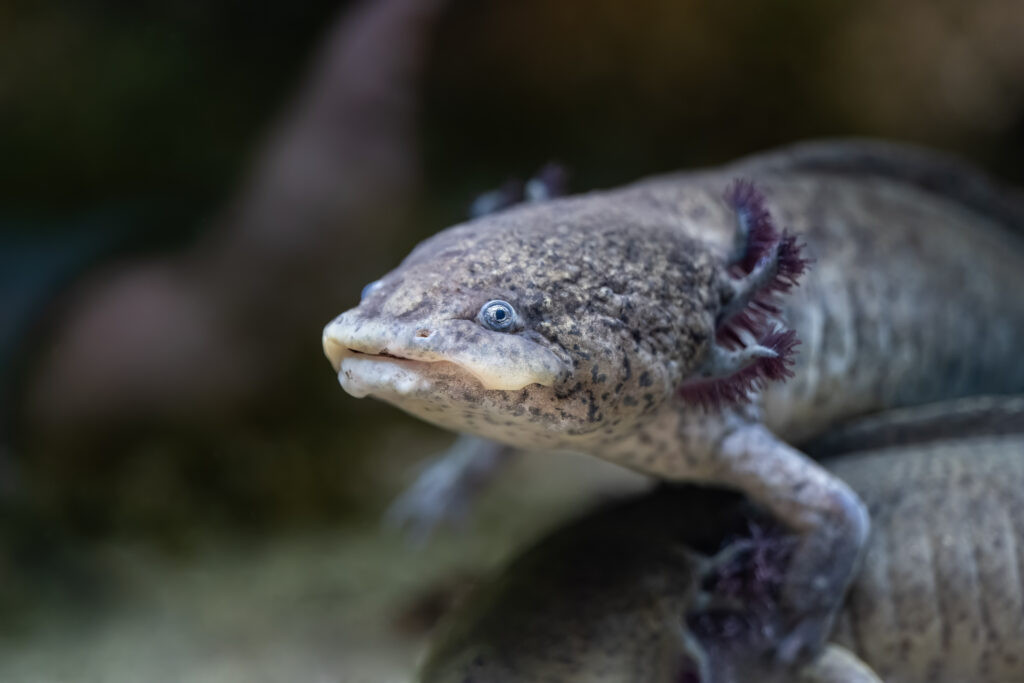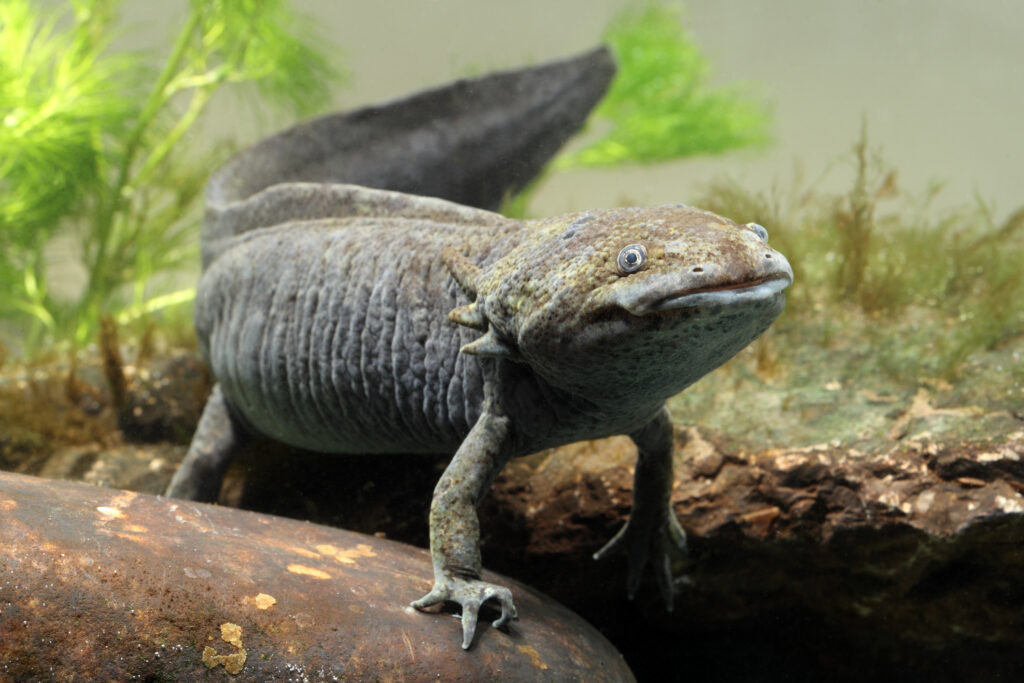The Mexican axolotl, a unique amphibian also known as the “walking fish,” is more than just a fascinating creature; it’s a symbol of resilience and a wonder of nature that captures the imagination of many, including the LGBTQ+ community in Mexico. Dive into the enchanting world of the axolotl with gaymexico.net, where we uncover its secrets and explore why it’s so special. Discover the axolotl’s natural habitat, conservation status, and the cultural significance it holds in Mexico, all while connecting with LGBTQ+ friendly destinations and communities.
1. Understanding the Mexican Axolotl
What exactly is a Mexican axolotl, and why is it so captivating?
The Mexican axolotl (Ambystoma mexicanum) is a type of salamander renowned for its neoteny, a condition where it retains its larval characteristics throughout adulthood. This means it keeps its tadpole-like features, such as feathery gills and a dorsal fin, even as a fully grown adult. Often called a “walking fish” due to its appearance and aquatic habitat, the axolotl is native to Mexico and holds significant cultural and scientific value. Its unique ability to regenerate lost limbs and organs has made it a subject of extensive research. Axolotls embody adaptability and uniqueness, traits that resonate with the LGBTQ+ community and its celebration of individuality.
1.1. What Does a Mexican Axolotl Look Like?
While axolotls in captivity often come in white or pale pink variations, wild axolotls typically exhibit darker colors. These colors include brown-gray with green or gold speckles. Key physical characteristics of the axolotl include:
- Size: Axolotls grow to an average length of 30 cm, though sizes can range from 15 to 45 cm, with a weight between 50-250g.
- Head: They feature wide heads with short limbs.
- Gills: Three pairs of external feathery gills distinguish them.
- Feet: Webbed feet help with movement in the water.
- Fin: A dorsal fin extends along the length of their body.
 Axolotl face close-up showing feathery gills
Axolotl face close-up showing feathery gills
1.2. Where Do Axolotls Live in Mexico?
Axolotls are native to Mexico, specifically the freshwater lakes of Xochimilco and Chalco, located in the southern part of Mexico City. Today, these creatures are rarely seen in person due to habitat loss and other environmental factors.
- Lake Xochimilco: This is the primary habitat for axolotls.
- Lake Chalco: Historically a habitat, now largely drained.
- Mexico City Canals: These waterways also support axolotl populations.
1.3. What Do Axolotls Eat?
Axolotls are carnivores with a diet consisting of:
- Worms
- Insects
- Crustaceans
- Molluscs
- Small fish
They use a suction method to capture prey, sometimes ingesting gravel to aid in digestion, as they have undeveloped teeth.
2. Cultural Significance and Mythology
How are axolotls viewed in Mexican culture and mythology?
For centuries, axolotls have held an important place in Mexican culture. According to local mythology, the axolotl is an embodiment of an Aztec god who disguised himself as a salamander to avoid sacrifice. This connection to ancient deities gives the axolotl a mystical aura, further enhancing its appeal. Sadly, they’re also viewed as a delicacy within Mexico City, with overfishing contributing to their appearance on the critically endangered species list.
2.1. Axolotls in Aztec Mythology
In Aztec mythology, the axolotl is associated with Xolotl, the Aztec god of fire, lightning, and death. Xolotl was believed to be the twin brother of Quetzalcoatl, one of the most important deities in the Aztec pantheon.
2.2. Axolotls as a Delicacy
Historically, axolotls were consumed as a delicacy in Mexico City. This practice has contributed to their decline in the wild, as overfishing has significantly reduced their numbers.
3. The Axolotl’s Unique Biology
What makes the axolotl biologically unique and scientifically valuable?
The axolotl’s most remarkable trait is its ability to regenerate lost limbs, spinal cord, and even parts of its brain without scarring. This capability has fascinated scientists for decades, making the axolotl a key subject in regenerative medicine research. Studying the axolotl’s genetic makeup could potentially unlock treatments for degenerative diseases and injuries in humans.
3.1. Limb Regeneration
Axolotls can fully regenerate lost limbs, including bones, muscles, and nerves. This process occurs without forming scar tissue, allowing for perfect restoration of the limb.
3.2. Organ Regeneration
In addition to limbs, axolotls can regenerate parts of their spinal cord and brain. This ability is rare among vertebrates and makes the axolotl a valuable model for studying regenerative processes.
3.3. Scientific Research
Axolotls are extensively studied in laboratories around the world. Research focuses on:
- Regenerative medicine
- Developmental biology
- Genetics
- Cancer research
4. Conservation Status: Why Axolotls Are Endangered
What factors have led to the axolotl being classified as critically endangered?
The IUCN Red List classifies the axolotl as “critically endangered,” indicating that its population is rapidly declining. Several factors contribute to this alarming decrease in axolotl numbers. According to a study by Mexican biologist Luis Zambrano, the axolotl population in Lake Xochimilco plummeted from 6,000 per square kilometer in 1998 to just 35 today.
4.1. Water Pollution
The rapid development of Mexico City has led to significant water pollution in the Xochimilco network. Pollutants from urban runoff, industrial discharge, and agricultural activities contaminate the water, making it uninhabitable for aquatic life.
4.2. Habitat Loss
The expansion of Mexico City has resulted in the draining and destruction of the Xochimilco lake complex, including Lake Chalco. This habitat loss deprives axolotls of their natural environment and reduces their chances of survival.
4.3. Invasive Species
The introduction of non-native species, such as perch and tilapia, has disrupted the natural food chain in Xochimilco. These invasive species prey on axolotl eggs and larvae, reducing the recruitment of new individuals into the population.
4.4. Overfishing
Axolotls have historically been consumed as a delicacy in Mexico City, leading to overfishing. The demand for axolotls in local markets has contributed to the decline in their numbers in the wild.
4.5. Disease
In recent years, outbreaks of disease have further threatened axolotl populations. These diseases can spread rapidly in the wild, decimating already vulnerable populations.
5. Efforts to Save the Axolotl
What conservation efforts are in place to protect the axolotl?
Various organizations and researchers are working to conserve the axolotl and its habitat. These efforts include:
- Habitat Restoration: Restoring and protecting the remaining wetlands in Xochimilco is crucial for the axolotl’s survival.
- Water Quality Improvement: Reducing pollution in the Xochimilco canals is essential for creating a healthy environment for axolotls.
- Captive Breeding Programs: Breeding axolotls in captivity can help maintain genetic diversity and provide individuals for reintroduction into the wild.
- Community Engagement: Engaging local communities in conservation efforts can promote sustainable practices and reduce threats to axolotl populations.
- Research and Monitoring: Ongoing research and monitoring are needed to track axolotl populations and assess the effectiveness of conservation efforts.
6. The Connection to LGBTQ+ Mexico
Why does the axolotl resonate with the LGBTQ+ community in Mexico and beyond?
The axolotl, with its unique appearance and remarkable resilience, symbolizes diversity and adaptability. These traits resonate deeply with the LGBTQ+ community, which also celebrates individuality and strength in the face of adversity.
6.1. Symbolism of Diversity and Uniqueness
The axolotl’s distinctive appearance sets it apart from other amphibians, making it a symbol of uniqueness. Similarly, the LGBTQ+ community embraces diversity and celebrates the differences that make each individual special.
6.2. Resilience and Adaptation
The axolotl’s ability to regenerate lost limbs and organs reflects resilience and adaptation. These qualities mirror the LGBTQ+ community’s ability to overcome challenges and adapt to changing social landscapes.
6.3. LGBTQ+ Tourism and Conservation
By visiting and supporting destinations committed to conservation and inclusivity, LGBTQ+ tourists can contribute to protecting the axolotl and its habitat. This form of responsible tourism supports both environmental and social causes.
7. Exploring LGBTQ+ Friendly Destinations in Mexico
Looking for destinations where you can connect with the local LGBTQ+ community and support conservation efforts?
Mexico offers numerous welcoming destinations for LGBTQ+ travelers. These locations provide safe and inclusive environments, as well as opportunities to learn about local conservation initiatives.
7.1. Puerto Vallarta
Known as one of the most gay-friendly cities in the world, Puerto Vallarta boasts a vibrant LGBTQ+ scene. Visitors can enjoy:
- Gay beaches
- Lively nightclubs
- Welcoming hotels
- Cultural tours
7.2. Mexico City
The capital city is a hub of LGBTQ+ culture, offering:
- Pride parades
- Gay neighborhoods like Zona Rosa
- Historical landmarks
- Museums
7.3. Cancun
Beyond its stunning beaches, Cancun provides:
- Gay-friendly resorts
- Nightlife
- Opportunities for water sports
- Eco-tours
8. Discovering LGBTQ+ Events and Resources
What LGBTQ+ events and resources can you find in Mexico?
Mexico hosts a variety of LGBTQ+ events throughout the year, providing opportunities to connect with the community and celebrate diversity. Additionally, several organizations offer resources and support for LGBTQ+ individuals.
8.1. Pride Events
- Mexico City Pride: One of the largest Pride celebrations in Latin America, featuring a parade, concerts, and cultural events.
- Puerto Vallarta Pride: A vibrant celebration with parades, parties, and community events.
8.2. LGBTQ+ Organizations
- All Access Mexico: Advocates for LGBTQ+ rights and provides resources for the community.
- Address: 3255 Wilshire Blvd, Los Angeles, CA 90010, United States
- Phone: +1 (213) 380-2177
- Website: gaymexico.net
- Letra S: A non-profit organization working to promote LGBTQ+ rights and health in Mexico.
- Yaaj México: An organization focused on advocating for the rights of transgender individuals in Mexico.
9. Tips for LGBTQ+ Travelers in Mexico
How can LGBTQ+ travelers ensure a safe and enjoyable trip to Mexico?
Traveling as an LGBTQ+ individual requires some planning to ensure safety and comfort. Here are some tips to keep in mind:
9.1. Research Local Laws and Customs
While Mexico has made significant progress in LGBTQ+ rights, attitudes can vary depending on the region. Research local laws and customs to be aware of potential challenges.
9.2. Choose LGBTQ+ Friendly Accommodations
Opt for hotels and guesthouses that openly welcome LGBTQ+ guests. These establishments often provide a more comfortable and inclusive environment.
9.3. Connect with Local LGBTQ+ Communities
Engage with local LGBTQ+ organizations and community centers to gain insights and support. Connecting with local activists can enhance your understanding of the local context.
9.4. Be Mindful of Public Displays of Affection
While major cities are generally accepting, be mindful of public displays of affection in more conservative areas. Avoid overt displays of affection in public spaces.
9.5. Stay Informed and Vigilant
Keep up-to-date with current events and travel advisories. Stay vigilant and trust your instincts when navigating unfamiliar environments.
10. Protecting Axolotls: What Can You Do?
How can you contribute to axolotl conservation efforts?
Supporting axolotl conservation is crucial to ensure the survival of this unique species. Here are some ways you can help:
10.1. Support Conservation Organizations
Donate to organizations working to protect axolotls and their habitat. Financial contributions can help fund research, habitat restoration, and community engagement.
10.2. Advocate for Sustainable Tourism
Choose eco-friendly tour operators and accommodations that prioritize conservation. Support local businesses committed to sustainability.
10.3. Reduce Your Environmental Impact
Practice responsible travel habits, such as reducing waste, conserving water, and minimizing your carbon footprint. Every small action can make a difference.
10.4. Educate Others
Share information about axolotls and the threats they face. Raising awareness can inspire others to take action.
10.5. Visit Xochimilco Responsibly
If you visit Xochimilco, choose tour operators that respect the environment and support local communities. Avoid activities that could harm the axolotl’s habitat.
 Axolotls swimming in an aquarium
Axolotls swimming in an aquarium
FAQ: Frequently Asked Questions About Mexican Axolotls
1. What is neoteny, and how does it relate to axolotls?
Neoteny is a condition in which an organism retains its larval characteristics throughout adulthood. Axolotls are known for their neoteny, which means they keep their tadpole-like features, such as feathery gills, even when they are fully grown.
2. Are axolotls only found in Mexico?
Yes, axolotls are native to Mexico, specifically the freshwater lakes of Xochimilco and Chalco, located in the southern part of Mexico City.
3. Why are axolotls called “walking fish”?
Axolotls are often called “walking fish” due to their appearance and aquatic habitat. Their short limbs and ability to walk along the bottom of lakes give them a fish-like appearance.
4. What is the conservation status of axolotls?
The IUCN Red List classifies the axolotl as “critically endangered,” indicating that its population is rapidly declining.
5. What factors contribute to the decline in axolotl populations?
Several factors contribute to the decline in axolotl populations, including water pollution, habitat loss, invasive species, and overfishing.
6. How do axolotls regenerate lost limbs?
Axolotls can fully regenerate lost limbs, including bones, muscles, and nerves. This process occurs without forming scar tissue, allowing for perfect restoration of the limb.
7. What is the significance of axolotls in Aztec mythology?
In Aztec mythology, the axolotl is associated with Xolotl, the Aztec god of fire, lightning, and death. Xolotl was believed to be the twin brother of Quetzalcoatl, one of the most important deities in the Aztec pantheon.
8. How can I support axolotl conservation efforts?
You can support axolotl conservation efforts by donating to conservation organizations, advocating for sustainable tourism, reducing your environmental impact, and educating others about axolotls.
9. Are there captive breeding programs for axolotls?
Yes, there are captive breeding programs for axolotls. These programs help maintain genetic diversity and provide individuals for reintroduction into the wild.
10. How can LGBTQ+ travelers contribute to axolotl conservation?
LGBTQ+ travelers can contribute to axolotl conservation by supporting conservation organizations, advocating for sustainable tourism, and reducing their environmental impact. By visiting and supporting destinations committed to conservation and inclusivity, LGBTQ+ tourists can contribute to protecting the axolotl and its habitat.
Conclusion: Embrace Diversity and Conservation with gaymexico.net
The Mexican axolotl is not just a fascinating creature; it is a symbol of diversity, resilience, and the importance of conservation. At gaymexico.net, we encourage you to explore the beauty of Mexico, support LGBTQ+ friendly destinations, and contribute to protecting the axolotl and its habitat.
Ready to discover more about LGBTQ+ travel in Mexico? Visit gaymexico.net today for comprehensive guides, event listings, and resources to help you plan your next adventure! Whether you’re seeking vibrant nightlife in Puerto Vallarta, cultural experiences in Mexico City, or eco-tours in Cancun, gaymexico.net has everything you need to make your trip unforgettable. Connect with the local LGBTQ+ community, explore stunning landscapes, and support conservation efforts that protect the unique biodiversity of Mexico. Start your journey now and experience the magic of Mexico with gaymexico.net!
